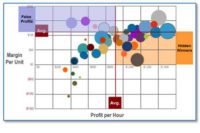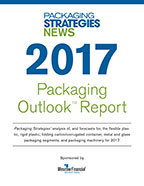Changes in the supply chain
Packaging productivity and profitability

Important changes are prevalent in today’s packaging market dynamics. Historically, consumer goods manufacturers shipped pallets to warehouses and then to stores. Increasingly, consumers are making purchases online, rather than at brick and mortar stores. The warehouse-centered model, with more shipments bypassing retail outlets and going directly to consumer homes, calls for different automation efficiencies than that of the conventional retail supply chain. As a result, many consumer products require added packaging protection to prevent damage during shipment. And, packaged quantities and carton sizes vary more widely so manufacturers can optimize warehouse-to-consumer shipping costs.
Demand is rising for consumer goods packaging applications, such as pick & place, mixed pallets and cases, cartoning and packing for shipment. Machine builders and system integrators must be vigilant about identifying areas of savings. Bottom line machine costs come down to parts count including gearing, motor, inverter or servo drive. Design engineers leave money on the table if they build machines according to outdated specifications for drive efficiencies as low as 50-60%. Savings can be substantial by switching to new gearing technology that yields 90-95% efficiency.
Robots are increasingly common in the packaging industry, which creates special challenges for machine builders because complete robots, including the control system or individual kinematics, must be integrated into the automation system. Robotic software and programming are becoming easier and more flexible. The use of standardized, reusable software modules is a straightforward approach to simplify configuration of robotic movements and integration with machine control functions. This leaves machine builders to focus on increasing machine performance, added functionality, and equipment energy efficiency—results that truly enhance machine value.
These and other strategies can help packaging machine builders and system integrators and operators optimize machine and robotic productivity and profitability.
Decentralized machine control architecture evolves
Machine builders have traditionally focused on optimization at the packaging machine and plant level. In the past, there have been cells with robotic functions that were distinct and separate from other machine functions. Within the packaging industry, there is heightened interest in automation control, especially around the integration of robotic and machine functionality.
As more packaging plants, warehouses, and distribution centers come on line with decentralized control architectures, the right combination of technologies is critically important. Decentralized control allows a drive package to be part of an enclosure or mounted directly on the equipment, which puts the power at the motor shaft. This provides numerous advantages, including smaller cabinet size, reduced heating within the cabinet, lower requirements for wiring, and faster commissioning. Moving high voltage out of a central cabinet also alleviates the need for service personnel and engineers to wear full protective equipment when working on the system.
Decentralized motion control can reduce, and even eliminate, the load on the machine control system. Inverter drives are capable of taking over decentralized control responsibilities. An I/O system can be incorporated into the system to evaluate the control signals. An end-to-end network can be established using EtherCAT or CANopen, with access via a scalable visualization concept.
The overall decentralized system can incorporate a range of high-efficiency motors and gearboxes designed for industrial automation tasks. Packaging operations are also yielding energy cost savings, as more machines come equipped with economy modes for improved efficiency during times when conveyors are not in operation or running lightly loaded.
Machine configuration software breaks down programming barriers
Historically, developers used ladder logic and other classic programming languages to program machine tasks. That required extensive training and a comprehensive knowledge of the programming language. Despite the high bar, machine designs often re-created the wheel by relying on code from earlier versions of the machine. When it was time for installation, an engineer would have to go onsite with a laptop, identify the correct software needed for the specific machine, and load configuration files. These approaches yield multiple redundancies and incur unnecessary expenses at nearly every level.
Software can have a major impact on reducing programming time, which goes right to the bottom line of machine productivity and profitability. Within the industry there is clear need and demand to streamline machine and robotic design processes to better utilize engineering resources. Application software that enables design engineers to solve productivity challenges is an important new trend in packaging.
Machine design application software leverages known motion control functions and incorporates these proven movements into preconfigured blocks of control functionality. Replacing complex programming with uniform machine configuration software tools can significantly reduce engineering time and technical requirements, and eliminate redundancies that drive up cost. Rather than mastering programming languages, valuable engineering time can be strategically directed at enhancing a machine’s exciting and value-added performance factors.
Lenze (lenze.com) FAST helped lower engineering costs and reduce design time to enable faster delivery times for AB Graphic International, a global manufacturer of label converting and finishing equipment. The company operates multiple inspection rewind equipment, including RFID tag insertion, laser die cutting, booklet label machines and 100 percent camera inspection systems. Production runs are shrinking with rising demand for custom, localized services. Digital printing machines and PC-based systems are replacing conventional flexographic presses. Yet, productivity still relies on motion control—winding quality, faster changeover times, easy maintenance and reliability. AB Graphic needed strategies to keep pace with the digital era.
As a result, servo technology offered the best solution with unrivaled mechanical flexibility and precise tension control. AB Graphic chose to replace mechanical systems with the latest Lenze i700 servo inverter technology and adopt FAST application template function blocks. The i700 servo inverter solution provided a straightforward topology with reduced wiring requirements. The company can now easily interlink the DC power supply bus and EtherCAT connections, without requiring circuit breakers or individual mains supplies. Featuring double-axis and single-axis drives, the new inverters substantially reduced cabinet footprint by 15 to 20%.
The FAST software allows the company’s design engineers to plug blocks of predesigned control function modules into a template with which they can create machine control functions. The modules are effectively programs that run autonomously, so they can be easily exchanged and independently tested. All of the variables, including I/O and HMI data, exist as structures within the module. Approximately 80% of software developed for most new machines can be generated using code developed for previous generations. Leveraging this knowledge and field-tested function with technology modules for machine programming represents an enormous leap forward from the days of copying lines of code from old projects to paste into new ones.
Compliant with IEC 61131 and PLCOpen, FAST tools enable integration of automation components from multiple suppliers via EtherCAT and other open network communication standards. Machine designers and programmers can use the FAST tools, which include an application template and ready-made standard software modules, to handle most software engineering requirements for standardized machine modules. FAST provides a complete range of standard software modules for positioning, registration, cam profiling, multi-conveyor coordination and other synchronized motion control tasks, including modules for feeding unwinding, sealing, cross-sealing and discharging applications, in addition to simple and advanced modules for delta, gantry and other robotic applications. The template also includes important structures for key functions, such as switching over machine states, error handling, and communication interfaces.
The company’s new label converting system can hold prepress parameters, label sizes, slit width, quality and roll size. This information enables them to automatically configure machines without operator intervention for running smaller batches with faster changeover times. The new solution has also improved the quality of performance. Instead of a web encoder, the user can now use a virtual master combined with the FAST winding module, which results in better control of web tension. The software and controller combination uses open network industry standards to streamline M2M communications. This gives them the benefit of a decentralized topography combined with the seamless integration and supervisory control of upstream and downstream equipment.
Higher performance hybrid drive solutions at a lower price-point
Determining speed and torque needed at the shaft is critical to drive optimization. An oversized drive costs more and generates heat in the gearbox, rather than transferring that heat into power at the machine level. An undersized drive delivers insufficient power for the application, which can result in downtime, higher maintenance and energy inefficiencies.
Servo motors are ideal for applications requiring optimal precision and dynamic performance, with recurring motion sequences and perfectly coordinated return systems. However, not all packaging tasks require that level of precision, performance and higher cost associated with a servo motor. Dynamic speed, torque and precision motion control can be achieved with a hybrid option, such as a powerful inverter in combination with an asynchronous motor.
An induction or standard AC motor in a hybrid architecture solution may be the best and most cost-effective option for some machine applications. When a servo motor is ruled out, yet there’s need for the capability to handle a semi-complex series of commands—that’s where a hybrid design can be the answer—the Lenze Highline 8400. This versatile solution blends the simplicity of a conventional AC motor with electronic drive control technology. It gives power and freedom in motion control with freely adjustable speeds, programmable I/O and integrated functions. A closed loop system in both a positioning and a torque mode, the system uses a PROFINET plug-in network communication module.
Delivering up to 200% rated torque, the Highline 8400 performance pushes into levels that would previously have required servo technology, with positioning accuracies of 0.1mm at 60 operations (120 movements) per second. The savings obtained by choosing an induction motor over a servo motor can be significant, with a 20-50% average price differential between the technologies.
The right time for critical analysis and cost savings
Modern packaging operations need customized drive solutions. The automation industry is committed to continuous improvement to help ensure that manufacturers, machine builders and automation system integrators can achieve their motion control design goals. From integrated motor drive solutions to standardized software configuration modules, a range of technologies exist for enhancing packaging machine and system performance, functionality and value.
Industry experience counts when choosing a motion control partner-supplier to assess a machine concept and help specify optimal power, torque and speed. The time for critical analysis and cost savings is before finalizing the drive train, gearing and motor drive for a packaging task. A mechatronic design approach can break down barriers between mechanical and control engineering, and assess the entire system from a cost and performance standpoint. From the shaft to the inverter or servo drive to the application software, there are opportunities for performance benefits and potential savings at every stage of machine development and system integration.
Looking for a reprint of this article?
From high-res PDFs to custom plaques, order your copy today!







